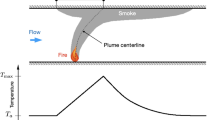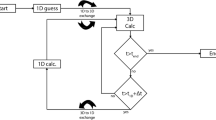Abstract
A model of major fire spread in a tunnel is described. It employs the concepts of non-linear dynamical systems theory and identifies the onset of instability with major fire spread in a tunnel. In particular, the model associates the existence of a fold bifurcation with dramatic fire spread from an initial fire to a ‘target object’. The purpose is to identify the thermo-physical and geometrical conditions which lead to instability and sudden fire spread. Flame impingement on the target object is assumed not to exist; fire spread is assumed to be by spontaneous ignition only.
The case considered assumes the existence of a longitudinal forced ventilation and predicts the critical heat release rate needed for a fire to spread from an initial fire to an item with a given assumed shape. The target object may be taken to approximate a vehicle. The illustrative case approximating fire spread from an initial fire to a heavy goods vehicle (HGV) within the Channel Tunnel is presented; it is not restricted to this case, however. The model is identified with the name FIRE-SPRINT A3, which is an acronym of Fire Spread in Tunnels, Model A, Version 3. It is a development of an earlier model, FIRE-SPRINT A2. The current model takes greater account of thermal radiation than was done in the earlier work and also assumes a more extensive flame volume for a downstream flame section.
Similar content being viewed by others
References
D.A. Charters, W.A. Gray and A.C. McIntosh, “A Computer Model to Assess Fire Hazards in Tunnels”, Fire Technology, 30,1994, pp. 134–154.
N. Rhodes, ‘The Accuracy of CFD Modelling Techniques for Fire Prediction’, 3rdInt Conference on Safety in Road & Rail Tunnels, Nice, 9–11 March, 1998; organized by University of Dundee and International Technical Conferences Ltd
S. Powell, and S. Grubits, ‘Tunnel Design with TRAFFIC-Tunnel Risk Assessment for Fire Incidents and Catastrophes’, Int Conference on Tunnel Fires & Escape from Tunnels, Lyon, 5–7 May, 1999; organized by Independent Technical conferences Ltd.
J.M.T. Thompson, and H.B. Stewart, Nonlinear Dynamics and Chaos, Wiley, Chichester, 1986
A.N. Beard, D.D. Drysdale, P.G. Holborn, and S.R. Bishop, “A Non-Linear Model of Flashover”, Fire Science & Technology, 12, 1992, pp. 11–45.
A.N. Beard, D.D. Drysdale, P.G. Holborn, and S.R. Bishop, “A Model of Instability & Flashover”, Journal of Applied Fire Science, 4, 1994/5, pp. 3–16.
P.H. Thomas, “Fires and Flashover in Rooms—A Simplified Theory”, Fire Safety Journal, 3, 1980/81, pp. 67–76.
P.H. Thomas, M.L. Bullen, J.G. Quintiere, and B.J. McCaffrey, “Flashover and Instabilities in Fire Behavior”, Combustion and Flame, 38, 1980, pp. 159–171.
A.N. Beard, D.D. Drysdale, and S.R. Bishop, “A Non-Linear Model of Major Fire Spread in a Tunnel”, Fire Safety Journal, 24, 1995, pp. 333–357.
A.N. Beard, “A Model for Predicting Fire Spread in Tunnels”, Journal of Fire Sciences, 15, 1997, pp. 277–307.
R. Thom, Structural Stability & Morphogenesis, Benjamin, Inc., Reading, Massachusetts, U.S.A., 1975.
J.L. Willems, Stability Theory of Dynamical Systems, Nelson, London, 1970.
S.E. French, “Fire Safety in the Channel Tunnel: an Overview”, Int Conf on Fires in Tunnels, Boras, Sweden, 10–11, Oct, 1994. Compiled by E. Ivarson, Swedish National Testing & Research Inst.; ISBN 91-7848-513-4.
R.O. Carvel, A.N. Beard, P.W. Jowitt, and D.D. Drysdale, “Variation of Heat Release Rate with Forced Longitudinal Ventilation for Vehicle Fires in Tunnels”, Fire Safety Journal, 36, 2001, pp. 569–596.
R.E. Bolz, and G.L. Tuve, (eds.,), Handbook of Applied Engineering Science, Chemical Rubber Company, Cleveland, USA, 1970.
R.J. Bettis, S.F. Jagger, and Y. Wu, “Interim Validation of Tunnel Fire Consequence Models: Summary of Phase 2 Tests”, Health & Safety Executive Fire Laboratory, Buxton, Derbyshire, 1993.
R.L. Alpert, “Influence of Enclosures on Fire Growth: Vol 1; Test Data, Test 7”, Report No. OAOR2, Factory Mutual Research Corporation, Norwood, Massachusetts, USA
G.T. Atkinson, and D.D. Drysdale, “Convective Heat Transfer from Fire Gases”, Fire Safety Journal, 19, 1992, pp. 217–245.
D.D. Drysdale, Introduction to Fire Dynamics, Wiley, Chichester, 1985.
I.I. Rubin, (ed.,) Handbook of Plastic Materials & Technology, Wiley, New York, 1990.
Author information
Authors and Affiliations
Rights and permissions
About this article
Cite this article
Beard, A.N. A Theoretical Model of Major Fire Spread in a Tunnel. Fire Technol 42, 303–328 (2006). https://doi.org/10.1007/s10694-006-7253-y
Published:
Issue Date:
DOI: https://doi.org/10.1007/s10694-006-7253-y




